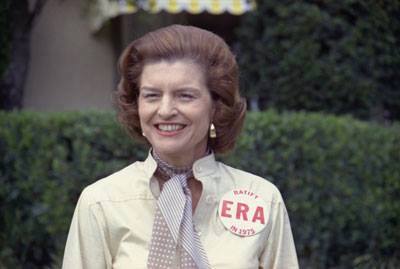April 9, 1975: Public support for the Equal Rights Amendment remains overwhelming, according to a Gallup Poll released today.

Fifty-eight percent of the 1,542 respondents polled between March 7th and 10th said they favored the Constitutional amendment which would permanently and explicitly ban all forms of sex discrimination, while just 24% were opposed, and 18% had no opinion.
Support for the E.R.A. was strongest among those under 30, and those in the East (both 67%). Men were actually more supportive (63%) than women (54%) though clear majorities of both groups favored it.
Opposition was greatest among women over 50, only 46% of whom supported it, and in the South, though even there 52% were in favor.
The E.R.A. was written by Alice Paul, and the campaign for it was launched by the National Woman’s Party on July 21, 1923.
It was introduced into the U.S. Senate on December 10, 1923 by Senator Charles Curtis, and into the House on December 13, 1923 by Representative Daniel Read Anthony (a nephew of Susan B. Anthony). Both men were Kansas Republicans.
The E.R.A. has had the support of the Republican Party since 1940, Democrats since 1944, and every President since Harry Truman took office in 1945. First Lady Betty Ford is an especially active supporter.
The E.R.A. was passed by the House on October 12, 1971 by a vote of 354-23, then by the Senate on March 22, 1972 by 84-8.
A separate resolution, not in the text of the amendment itself, has given it until March 22, 1979 to gain the approval of 3/4 (38) of the 50 state legislatures required for ratification.
None of the first 17 Amendments had a deadline, nor did the 19th.
Twenty-two states approved the E.R.A. in 1972. Eight more joined them in 1973, and three more in 1974. North Dakota approved it on February 3rd of this year, bringing the total to thirty-four.
Three are expected to consider it this year: Florida, North Carolina and Missouri.
The Equal Rights Amendment is needed because with the exception of the 19th Amendment, which applies only to voting rights, no amendment to the Constitution was designed for the purpose of banning ANY form of sex discrimination.
Therefore the Supreme Court has never
felt compelled to rule that laws which discriminate on the basis of sex should be subject to the same “strict scrutiny” test that is used to judge laws which discriminate on the basis of race, religion or national origin.
Almost 187 years after the Constitution took effect on June 21, 1788 it’s long past time for sex bias to be explicitly and permanently prohibited. Laws that discriminate against women – or men – should not be judged according to some uncertain standard that changes with every new Supreme Court appointment.
The E.R.A. has three sections:
“Section One: Equality of rights under the law shall not be denied or abridged by the United States or by any state on account of sex.
“Section Two: The Congress shall have the power to enforce, by appropriate legislation, the provisions of this article.
“Section Three: This amendment shall take effect two years after the date of ratification.”
Gallup pollsters also asked women: “All things considered, who has a better life in this nation, men or women ?”
Three years ago 34% of women thought they had life better. This year only 26% thought so.
If this growing dissatisfaction can be translated into action on the E.R.A., those four more states can be won, hopefully in time for the nation’s Bicentennial next year!





